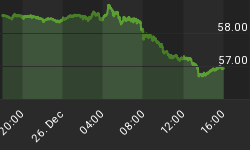It seems the Fed has given up on the idea that the country can build a viable and stable economy through the conventional means. Instead, our central bank has resorted to once again growing GDP and increasing employment by the creation of asset bubbles. This is a dangerous game that no one, least of all the Fed, knows how to play.
We learned this past Wednesday that the FOMC decided to increase its purchases of longer-dated Treasuries by $600 billion within the next eight months. That means the Fed is on course to fund about 75% of our annual deficit! Such figures are the stock in trade of banana republics. While most of the rest of the world is fighting inflation and strengthening their currencies, we are doing everything in our power to end the dollar's status as the world's reserve.
Canada, China, India, Brazil, and Australia have all recently taken steps to raise interest rates and/or curtail bank lending. Compare that to the US, which has left interest rates at near-zero for almost two years. While other central bankers are tamping down expansionary rhetoric, Fed Chairman Bernanke is on record saying that he will do everything in his power to push up inflation (which he considers too low) and dilute the dollar. Foreign central banks and other investors may soon reconsider their plans to park cash in dollar-denominated assets. In fact, there has been a series of angry statements from top economic policymakers in Beijing, Berlin, Moscow, and Sao Paolo that show rising discontent with Washington.
The Fed rationalized its decision to upset the global monetary order in a November 4th op-ed by Chairman Bernanke entitled, "What the Fed did and why." Here's an excerpt:
"Although asset purchases are relatively unfamiliar as a tool of monetary policy, some concerns about this approach are overstated. Critics have, for example, worried that it will lead to excessive increases in the money supply and ultimately to significant increases in inflation. Our earlier use of this policy approach had little effect on the amount of currency in circulation or on other broad measures of the money supply, such as bank deposits. Nor did it result in higher inflation. We have made all necessary preparations, and we are confident that we have the tools to unwind these policies at the appropriate time. The Fed is committed to both parts of its dual mandate and will take all measures necessary to keep inflation low and stable."
But the facts contradict Bernanke's claims that monetary policy has not pushed up inflation. The Fed began the current round of accommodation in September of 2007 with a 50 basis point reduction in the Fed funds rate. At that time, the M2 money stock was $7.40 trillion. It has since jumped 18.5% to $8.77 billion. This increase is showing up in the form of higher prices.
The 19 commodities that make up the CRB Index have soared 55% since the beginning of 2009. Unless the Chairman desires to return to an environment where oil is trading at $147 a barrel, these surging commodity prices are already placing consumers and corporations under inflationary duress.
Here's where the danger lies ahead. Before the recession began in 2007, the ratio between M2 and the monetary base was about 10:1. If the Fed sticks to its announced schedule, the size of the base should grow from $1.96 trillion to about $2.6 trillion by June of 2011. Once banks start lending again and expanding base money through the fractional reserve system, M2 could increase exponentially. An increase in the money supply to $26 trillion (in line with the historic 10-to-1 ratio) would result in a major inflationary shock. However, even if the money multiplier were to remain much lower, the M2 money stock would still be much higher than today. In fact, the compounded annual increase of M2 in the last 4 weeks is currently over 9%.
Unless Bernanke has a "road to Damascus" moment, the money supply will continue to grow and inflation will accelerate over the course of the next few years. To make matters much worse, the interest expense on the nation's debt could reach over 40% of all revenue by the year 2015.
Faced with negative real interest rates, rapidly rising inflation, and a chronically weak dollar, foreign holders of US Treasury debt and other dollar-denominated holdings may begin to lose their nerve. They may start to repatriate their savings and thereby send Treasury yields soaring. The Fed - which is the Treasury's buyer of last resort - will then be faced with a perilous decision. The central bank will have to either join foreign sellers of US debt in sending interest rates higher (in the hopes of giving the dollar some footing and allowing high rates to encourage the return of real buyers) or ramp up the printing presses to keep the long end of the yield curve from spiking. It should be obvious that the Fed has already made that decision. They will never allow rates to rise. The debt will be monetized.
I have no doubt that Bernanke will be remarkably successful in his stated goal of driving inflation higher. I simply disagree with his nonchalance about the long-term consequences. There is currently no easy exit strategy for the Fed. There is only the prospect of Americans suffering through either a deflationary depression or hyperinflation. To survive such storm requires careful planning. If only we could convince the big chief to stop doing his rain dance...
For in-depth analysis of this and other investment topics, subscribe to Euro Pacific's Global Investor Newsletter. Click here for your free subscription.
Click here to download Euro Pacific's Special Report: My Five Favorite Gold & Silver Mining Stocks.
Be sure to pick up a copy of Peter Schiff's just-released economic fable, How an Economy Grows and Why It Crashes.
















